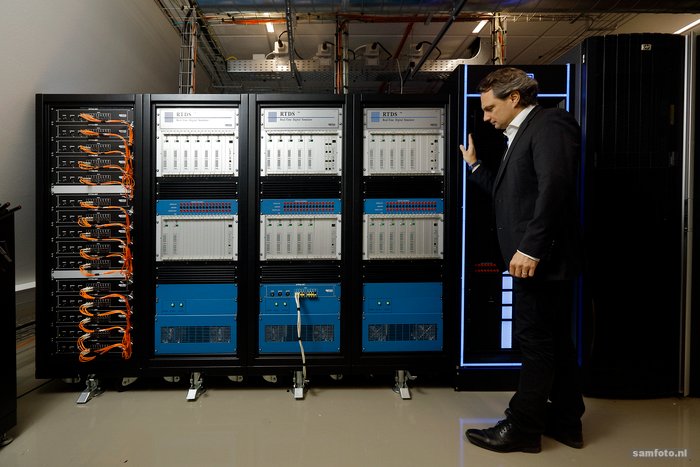Lifelike look-alike of the power grid
Professor Peter Palensky is developing a digital twin of the Dutch electricity grid, making it possible to do free research on innovations in the energy system without risking a blackout.
The digital twin of the energy network forms the ideal testing ground for research and experiments. The causes and effects are lifelike and totally virtual, with no risks of injury, damage or power cuts. But when a transformer or cable are physically connected in the new ESP Lab, they will go ‘pooff’ in the event of a short circuit or overload in the digital version of the grid.
Palensky’s goal is a supercomputer with sufficient computing power to model the entire Dutch energy network, including connections to neighbouring countries and crucial interconnectors to and from the UK, Norway and Denmark. Funding is still a barrier - hopefully a NWO application will help. “But we know it can be done,” says Palensky, "because a quarter has already been completed." He is referring to the digital twin of the grid in the northern Netherlands, modelled for a study on how hydrogen may impact the energy system. Building on that experience, the ‘big’ twin can be ready relatively quickly, he expects.
Unfathomable complexity
One thing such a digital twin excels in is weighing up a large number of mutually influencing variables and uncertainties. What happens when hydrogen is added to the energy mix on a large scale, what happens if the power of high voltage direct current (HVDC) technology really takes off - and what if it all happens at once?
Humanly speaking, so much complexity is hard to grasp. “Especially since the demand side will also take on a completely different dynamic,” says Palensky, mentioning some examples: new services such as flex-aggregators, electric vehicles that coordinate their charging and discharging behaviour via IoT. A supercomputer can easily calculate complex ‘what if’ scenarios - and thus provide guidance for decisions about investments or network architecture, for example. It is one of the reasons why the transmission system operator TenneT is a partner.
Cousins
Palensky's digital twin is not one digital clone, but comprises a whole clone family. ‘Cousins’, for example, are accurate enough for education and research, but because of risks and computing power, they are not perfect images of the net. “The ‘real’ work remains the domain of the energy network operators. They have the real data, the real parameters - and for security reasons they don't share them,” says the professor. For Palensky and his colleagues, this is not a problem. In fact, “The cousins enable us to freely investigate how the grid responds to, for example, cyber-attacks or extreme electrical forces, without the grid operators constantly getting stressed.”
Until recently, the Netherlands had a fairly orderly energy system: power was generated in a limited number of perfectly controllable power plants, and transported from there to the customers. The energy transition is radically changing these dynamics. Sustainable energy sources such as sun and wind mean a more fluctuating and less predictable supply that is also more fragmented - with large-scale wind and solar parks and solar panels on private roofs. The demand side is also changing dramatically, with the rise of electric transport and the electrification of heat supply and industrial processes that currently use natural gas. Together, these developments have an enormous impact on the energy grid and the grid operators: balancing and stability has become much more complex whilst gaining unique momentum. As Palensky says: "We are at a turning point in history and we have a real chance of changing the world for the better.”
